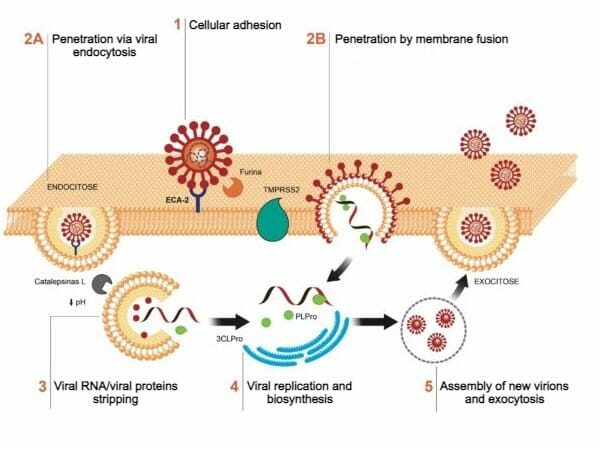
Transmission Mechanisms
Forms of transmission of SARS-CoV-2 and others
Droplets – Particles larger than 5 – 10 micrometers in diameter, projected by the infected when breathing, talking or coughing and coming into contact with the eyes, mouth or nose of the people around. These droplets precipitate on the ground quickly.
Aerosols – Particles smaller than 5 micrometers in diameter, projected by the infected and that can be inhaled by people nearby. These particles can remain in the air for long periods of time (about 3 hours in suspension). These particles move with the movement of the air and can reach several meters. This is a more unexpected form of transmission because people can be contaminated even in the absence of other people (e.g. in an elevator), even while keeping the safety distance of 2 meters or wearing a mask.
For example in a meeting room, if there is an infected person, even if wearing a mask, this will lead to an increasing viral load. If the meeting lasts for hours, this viral load may be enough to infect the other participants even if everyone wears a mask. On a car trip, this possibility will be much greater because the air volume in a car is low.
Surfaces – contaminated with viral particles. In this case, people touching such surfaces and putting their hand to their eyes, mouth or nose are at risk of becoming infected. The most normal contact will be via the hands, but it can be via the mouth or nose, such as when putting on a shirt during a fitting. In this case, the infected person who has tried on the clothes before, may have deposited viral particles on the clothes (for example, the collar of the shirt) by the simple fact of breathing or even via secretions (saliva).
See WHO (World Health Organization)
Other respiratory viruses
The routes of transmission of respiratory viruses include direct contact, contaminated breaths, and airborne droplets of secretion. The viruses most commonly involved in respiratory infections are rhinovirus, respiratory syncytial virus (RSV), coronavirus, adenovirus, parainfluenza, and influenza. Rhinovirus and respiratory syncytial virus (RSV) are spread in part by direct hand contact with contaminated skin and environmental surfaces, followed by self-inoculation of the virus through the nose or eyes. Others, such as influenza virus, measles virus, and varicella zoster virus, can spread over longer distances through small aerosol particles (mean diameter < 5 µm), but even then direct contact, breathers, and large particles are still important in transmission. Most respiratory viruses can spread via aerosols of large particles (> 5 µm) over short distances (< 1 m). Transmission of respiratory viruses can be amplified by exposure time, close contact, grouping of people, family size, and lack of pre-existing immunity. Infectivity usually precedes the onset of symptoms.

Bacteria
Bacteria are organisms formed by a single cell (unicellular), which is characterized by the absence of a defined nucleus (prokaryotes). The cellular organization of these organisms is quite simple, and no membranous organelles are observed. Bacteria can be found singly or in colonies and in various environments, such as water, soil, and in living beings.
Bacteria usually cause disease by producing toxins, which can be either endotoxins or exotoxins.
Endotoxins are located on the outer membrane of some bacteria. These bacteria release endotoxins only when they die and their cell walls are broken down. An example of bacteria that have this type of toxin is Salmonella typhi, responsible for causing typhoid fever. Exotoxins are produced and secreted by bacteria. An example of a bacterium that produces this type of toxin is Vibrio cholerae, responsible for causing cholera.
Diseases caused by bacteria have different forms of infection, symptoms, treatments and prevention. The characteristics of the bacteria’s cell walls are of great importance in the diagnosis and, consequently, in determining the best form of treatment. According to these characteristics bacteria can be classified as:
Gram-positive bacteria: The walls of these bacteria are simpler, consisting of peptideoglycans, a polymer of sugar and polypeptides.
Gram-negative bacteria: These bacteria have more complex walls than gram-positive bacteria, with fewer peptideglycans and a greater amount of lipids and amino acids. Another difference between these two groups is the presence of a membrane containing lipopolysaccharides (this lipid part is toxic). These bacteria are more resistant to antibiotics than gram-positive bacteria.
Transmission of pathogenic bacteria occurs through ingestion, inhalation of contaminated saliva droplets, through cracks or wounds in the skin, and even through sexual contact with an infected person. The symptoms depend on the causative agent and also on the form of contamination.
Dynasys – Engenharia e Telecomunicações, S.A.
Centro Empresarial Sado Internacional – Edifício E4
Estrada Nacional 10, Vale da Rosa
2910-835 Setúbal, Portugal
Tel: +351 265 706 900
Fax: +351 265 706 909
info@dynasys.pt
comercial@dynasys.pt

